Among the marine maintenance products Practical Sailor evaluated recently were 14 pump-spray mildew cleaners to find out which one was the most effective at removing severe mildew stains. We tested chlorine bleach cleaners, chlorine-free cleaners, hydrogen peroxide cleaners, and ammonium chloride cleaners on a variety of materials, ranging from mildewed shower curtains to moldy vinyl seat cushions and moldy life jackets. We also used them to clean a mildewed sail and mildewed Sunbrella. All products were effective at removing the mold mildew from the shower curtain, but the cushions, life jacket, Dacron sail, and Sunbrella were more of a challenge. One product stood out as a more effective mildew cleaner: Klean-Strip Mildew Stain Remover. Klean-Strip is a highly concentrated product with 19 times more sodium hypochlorite than common bleach, and we do not recommend it for cleaning sails or fabrics. Other products tested include 3M mildew stain remover, Boatlife mildew remover, MaryKate mildew stain remover, MDR Amazons Amazing Mildew Stain Away, MDR Moldaway, Naturally Clean Mildew, Nautical Ease Mildew Stain Remover, household Spray Nine, Star brite Mildew Stain Remover, Sudbury Mildew Cleaner and Stain Remover, Thetford Mildew Stain Remover, and West Marine Mold and Mildew Cleaner.
Every boatowner struggles with mildew. Not only is it ugly, but it stinks. Mildew, which is actually mold growing on fabric, plagues sails, lockers, cushions, cabin liners, life jackets, foul-weather gear, biminis-pretty much anything it can latch on to.
All mildew needs to grow is a moist environment with little ventilation, minimal light, and a food source-just about any organic matter. Before it grows, mold spores germinate on the food source. And boats offer an ample food supply: wood, paper, carpet, Sunbrella, vinyl, Dacron. When these materials become moist, it’s party time for the mold spores.
How fast mold grows depends on conditions like ventilation and humidity. Spores can germinate after only 12 hours in some conditions, and some grow in 24 to 48 hours. The secret is to prevent it or catch it as early as possible.
There are numerous products that claim to prevent or remove mildew. Sodium hypochlorite, or bleach, can kill fungus and mold spores if used correctly. Less-toxic chemicals like ammonium chloride are less effective at eliminating resistant molds but are less harsh on fabric and humans.
Once mildew appears, Practical Sailor recommends first trying a mix of mild soap and water to remove the mildew. The second line of defense is a chlorine-free mildew cleaner. Because some materials-like vinyl and stitching-can be damaged by repeated exposure to chlorine/bleach, its always a good idea to try removing the stains with less aggressive cleaners first (no chlorine or low chlorine). If that doesn’t work-and the material being cleaned isn’t affected by chlorine-try a more potent chlorine-based cleaner or a solution of 10 percent household bleach and 90 percent water to spot clean the stain; rinse thoroughly with fresh water and dry the area.
Some chemicals that eliminate mildew are considered pesticides, and may contain chemicals that can be harmful to people, animals, or the environment. For this reason, the U.S. Environmental Protection Agency’s Office of Pesticide Programs regulates pesticides in the United States to protect public health and the environment. Typical pesticides found in mold and mildew removers are chlorine and alkyl ammonium chlorides. These are known as fungicides and can be very caustic, ruining some fabrics or stitching, and harmful humans.
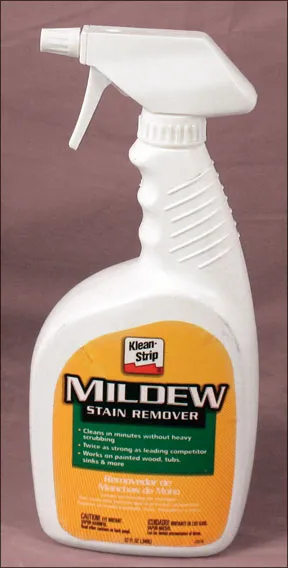
Reading the safety precautions on a product label before using a cleaner is a must. Many will recommend wearing gloves and eye protection.
The Mildew Removers We Tested
Practical Sailor tested 14 pump-spray mildew stain removers to find out which was the most effective at cleaning severe mildew stains. We do not recommend most of these be used for everyday cleaning, but the top performers are effective mildew stain removers.
Of the 14 cleaners tested, a half-dozen of them use sodium hypochlorite (bleach) as an active ingredient: Marykate Mildew Stain Remover, 3M Marine Mildew Stain Remover, Star brite Mildew Stain Remover, Klean-Strip Mildew Stain Remover, and Sudbury Mildew Cleaner & Stain Remover. The amount of bleach used varies from product to product. For instance, Klean-Strip is 96 percent sodium hypochlorite, and Boat Armor (no longer available) has 4.9 percent of the active ingredient, compared to the 5 percent found in household bleach.
Bleach-based products should never be used on nylon fabric or stitching. They will weaken the material. (See “Mildew Offense and Defense,” right.)
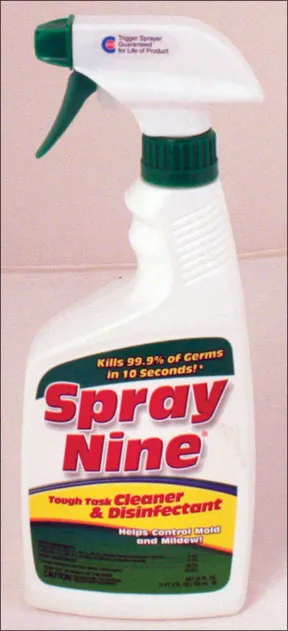
Eight test products-West Marine Mold & Mildew Cleaner, Marine Development and Research (MDR) Mold Away, MDR Amazons Amazing Mildew Stain Away, Nautical Ease Mildew Stain Remover, and BoatLIFE Mildew Remover, Spray Nine household cleaner, Thetford Mildew Stain Remover, and Naturally It’s Clean Mildew-are chlorine-free. Naturally It’s Clean uses “pure vegetable-based enzymes” and coconut oil as its active ingredients, while Thetford contains hydrogen peroxide, and Spray Nine uses ammonium chloride.
While several test products claim to be environmentally friendly (see comments on Value Guide, top right), only the Thetford cleaner has met EPA standards to carry the agency’s Design for the Environment (DfE) logo.
The Best Mildew Cleaners
We tested the cleaners on a variety of materials, ranging from shower curtains to vinyl seat cushions, life jackets, and sails (see “How We Tested,” above). All were effective at removing the mildew from the shower curtain. The life jacket and seat cushions proved to be more worthy opponents for our test group.
As we often do when testing large groups of boat maintenance products, we narrowed the field after the first round of testing, and let the top products duke it out in a clean-off.
In this test, the group of finalists was a large one: Eight cleaners did well at cleaning the vinyl cushions and moved on to face the life jacket, which was covered with dark black mildew stains. They were Spray Nine, Klean-Strip, Marykate, MDR Amazons Amazing cleaner, 3M, Star brite, and Sudbury.
Only one cleaner was effective at cleaning the life jacket: the high-chlorine-content Klean-Strip Mildew Stain Remover, a product manufactured by W.M. Barr & Co. in Memphis, Tenn. The website describes the product as a “professional strength cleaner.” The Klean-Strip line includes paint strippers, thinners and solvents, rust remover, and gum and adhesive removers.
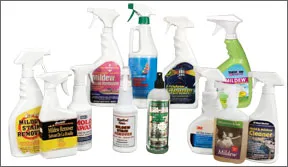
None of the products caused any apparent damage to the life-jacket material.
Practical Sailor prefers products without harsh chemicals-even if they require a bit more elbow grease. But none of those tested were so caustic that they were hard to work with, although the chlorine-based products did have a discernible bleachy smell.
Conclusions
Your best defense against mildew is prevention, but once those black stains appear, act fast. To avoid the possible damage that repeated exposure to harsh cleaners can cause, try to clean the stains first with soap and water, then a non-chlorine product.
Testers favorite bleach-free cleaner in this test was the Spray Nine. A top performer with the best price, Spray Nine also notched Budget Buy honors. Another top chlorine-free cleaner was Nautical Ease.
If the mildew problem is too tough for mild measures, advance to a diluted bleach-and-cold water solution-usually the cheapest approach-or a chlorine-based cleaner.
The hands-down top performer in this test was the bleach-based Klean-Strip. It stood out from the rest of the pack, easily cleaning the vinyl cushion and making a significant impact on the life jacket. It’s the Practical Sailor Best Choice for cleaning extreme mildew stains, but with caveats. This is a highly concentrated product-it has 19 times more sodium hypochlorite than common bleach-so be sure to read its label carefully and be selective about what surfaces and materials you use it on. We do not recommend using it undiluted for cleaning sails or fabrics.
Among the other bleach products that performed well, Marykate and Star brite are reasonably priced.
For the greenies out there, your best choice is the Thetford. While others claim to be eco-friendly, only Thetford has met the established DfE standard.
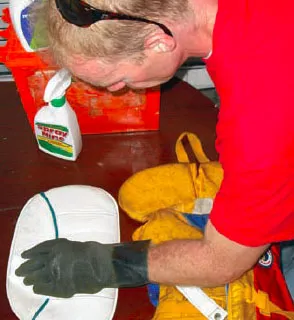
Practical Sailor tested 14 mildew cleaners on a mildew-plagued shower curtain, a moldy foam life jacket, and vinyl boat cushions. Not all of the test products are suggested for use on fabrics like life jackets. However, we wanted to test each cleaner to the same protocol to draw baseline conclusions. (For life jackets, most manufacturers recommend soaking them in a warm salt-and-water solution, then scrubbing affected areas, rinsing with fresh water, and allowing to dry in a well-ventilated spot. Once they’re dry, handwash with antibacterial soap, rinse, and hang them to dry.)
Testers closely followed the instructions on the product labels, noting effectiveness and ease of use. With most products, the user sprays it on and wipes with a cloth, sponge, or brush. Some require a wait after applying the cleaner before trying to remove the stains. The Nautical Ease and Amazon cleaners call for a wait as long as 10 to 15 minutes, while the Klean-Strip and 3M products require 5- to 10- minute wait times. Other products direct the user to spray them on, work them into the material with a brush, and then let the product sit for a while. Always be sure to thoroughly rinse the cleaned area with fresh water and allow it to dry.

The best way to fight mildew onboard is to keep it from ever starting in the first place. Prevention is your best defense. When storing your boat or leaving it closed up for an extended time, a few simple steps will help prevent mildew.
Clean and dry everything. Use a diluted water-bleach mixture on surfaces not likely to be damaged by the bleach. Wipe down and dry the head, shower, sinks, and the galley counters. Do the same for the overhead and walls/bulkheads.
Leave open all drawers, doors, and lockers to promote circulation. If covering the boat with a tarp, create ventilation between the tarp and the hull by hanging a few fenders between them. Prop up mattresses and cushions, or just remove them along with life jackets and foul-weather gear—even fenders and lines. Anything paper—charts, books, paper towels, etc.—should be stowed in air-tight bags or removed.
Good air circulation and moisture control go a long way toward keeping mildew at bay. Keeping the relative humidity below 55 percent throughout the boat gives you a good chance of preventing mold growth. Relative humidity can be measured by a hygrometer, available at many marine and air-conditioner stores, as well as some mega-retailers or hardware stores.
At the dock, a home dehumidifier, a dehumidifying stick (like the Golden Rod [www.goldenroddehumidifiers.com], effectively a small heater), or even a light bulb positioned under a vent can help promote air circulation and moisture removal. Moisture-absorption packets like silica gel can also help. These porous granules absorb up to half their weight in moisture from the atmosphere and can be purchased inexpensively in bulk at hardware stores.
The AbsorBag by Buffers USA (www.buffersusa.com) uses calcium chloride to absorb moisture. The company also sells a non-toxic desiccan’t bag, E-Sorb, that uses montmorillonite clay for absorption. Star brite makes similar products, the No Damp dehumidifier and MDG Mildew Odor Control Bags. PS plans to test these and other moisture absorbers.
Ventilation Products
Mildew thrives in humid, damp spaces, so keeping your cabin and lockers well ventilated is key. PS has tested numerous ventilation products and published a handful of articles on the subject.
We’re big fans of cowl vents coupled with Dorade boxes (PS May 15, 1997) to let air in but keep water out. A Dorade box is simply a water trap that employs a down-draft pipe offset laterally from the throat of the cowl vent. Vetus (www.vetus.com) supplies a wide range of well-made cowl ventilators.
Twelve-volt fans (PS Nov. 1, 2000 and April 2008) and solarpowered vents (PS May 1, 1993) also keep fresh air flowing in the cabin. The Hella Turbo fan (www.hellamarine.com) outlasted three other popular models in PS’s 2000 cabin fan longevity test. It also was among the recommended fans in our 2008 test.
Nicro Day and Night solar-powered vents (www.marinco. com) are another option. During the day, the solar panel charges a small Nicad battery to power the fan at night. In effect, you get 24-hour operation and continuous circulation.
Sails
Proper sail care and maintenance go a long way toward keeping those unsightly black blotches off your canvas. We culled the following tips from sail care experts and authors Dan Neri (“Sail Care and Repair”), William Burr (“Boat Maintenance”), and Roger McAfee (“The Warm Dry Boat,“ the Seattle sailors’ bible).
- Never stow sails when they are damp or salty as salt attracts moisture. (Fresh-water rinse salty sails.) Air them out regularly, especially after a rain.
- Keep mildew-infected sails away from clean ones, and try to clean infected sails as quickly as possible. Stains are easier to treat when they are new.
- Never use bleach on Kevlar or nylon as it will destroy the fibers. Washing these or Dacron sails in a chlorine-treated swimming pool will turn them brittle and yellow. To clean Dacron sails, first try lemon juice and water to spot clean and let them dry in the sun. For stubborn stains, try diluted Tilex, but be sure to rinse it off thoroughly to avoid longterm damage from the residue. To clean Kevlar, use only water. Lysol can be used as an effective fungicide.
- Laminates grow fungus more readily than woven polyester because the film is impermeable and moisture cannot escape.




























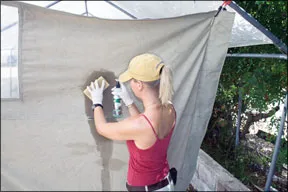





I think your writing so great. You had divided into some type of line product. I had tried one of eight cleaners did well at cleaning the vinyl cushions and moved on to face the life jacket, which was covered with dark black mildew stains as you told. Star Brite Mold and Mildew Stain Remover made me very surprised about its use. It required no scrubbing or effort. I simply sprayed it on and waited for about 3 minutes, then hosed it off. Done. Mildew 100% visually gone. I’ll follow your writing page to know more some line product of the other field
A few thoughts on mildew. Been a sailor on Lake Michigan for over 50 years and tried most of the liquid remedies with limited success. What I found very effective is an air cleaner that generates ozone. This is the device that hotels use to freshen up smoked in rooms, Put this in a closed boat for 1 day and all smells plus mildew on all surfaces gone for years. Cannot be in cabin while doing this however as ozone can be harmful. Another proven remedy for visable mildew on interior wood is pure lemon oil…the type available from gun shops for wood stocks. The oil has acedic acid that kills the spores, enriches the wood, and smells great. Most effective on non varnished interior wood like teak. Nothing new here just refreshing old ideas..
I’ve found that a solar vent is very effective at preventing mold. The principle is replacing humid daytime air that will deposit its moisture everywhere as it cools overnight, with cooler outside air that has already done so. The vent can be particularly helpful with people sleeping in the cabin–we generate a lot of humidity! The solar vent can be installed anywhere without wiring, and draws nothing from the boat’s batteries. The further it is located from where air enters, the better, but location isn’t that important–the exchange is. If you’re reluctant to cut a 3-4″ hole in the deck, mount it in a hatch that can be replaced if you decide this was a mistake.
I’m in sunny FL with a 40 footer and have a little Eva-Dry dehumidifier onboard. I run it off the batteries charged by the solar panels and it drains into the sink. No mildew inside. My problem is mold in the 40 year old teak on deck. It is in too deep for any cleaner to kill it. The teak is painted, but the mold shines through. Does anyone know if epoxying the teak before painting will keep it from shining through?
Please check your comment about Klean-Strip being 96% sodium hypochlorite. I believe the maximum chemically possible is less than 50%.
Maybe you ready that the “active ingredient” was 96% sodium hypochlorite. The SDS I saw on Barr’s website showed <5%. Pool Bleach is 10% and it will aggressively attack fabric.
I have an antique floor lamp covered in marlinspike work, but the apparently cotton sash cord has turned grey. Any ideas to brighten it?
Thanks.
Too bad that Klean-Strip Mildew Stain Remover has been discontinued according to the manufacturer. http://www.kleanstrip.com/product/discontinued
Thank You for updating this information. I have had good success with a line of products from Mold Armor. You might consider it in the future.
I have found the best results from Hydrogen Peroxide (first aid drug store type) in a spray bottle applied liberally to cloth, teak, leather or vinyl works very well and does not damage the surface being cleaned. I have used this to clean aboard my boat with great success.
I spray the boat interior with Walmart’s Equate brand similar to Lysol. The overhead, bulkheads, fabric, everything when I close up after a weekend. I have numerous solar exhaust fans mounted in my deck hatches and have plug in electric fans running in the cabins.
I recommend 3M Marine Mildew Stain Remover because it works great and versatile in cleaning different types of surfaces.
Was not expecting much but I have boat that was sitting for 8 years outside and had rust spots black mold and just about every stain you could think of. A few squirts of Better Boat Mildew Remover Stain Remover Cleaner stuff let it sit and honestly the boat looks new.
besides that, the Star Brite mold and mildew stain remover is great too. What I like about this product is the convenience it provides with its easy-usage features.
Marine 31 mildew remover is amazing. I had tried 5 other products that I had researched online and had good reviews to clean the mildew off of my boat seats and had almost given up on them until I found this. I bought it assuming I would get the same results as before, just a lot of scrubbing and money wasted on something that was useless, but I gave it a try anyway. I am so glad I did. When the bottle arrived I immediately went out and sprayed all of my seats, grabbed the brush to scrub them and the seat I sprayed first was totally clean. Yes you read that right. I would definitely recommend this product to anyone with a boat or who had outside furniture that gets any mold/mildew. It is safe on most materials and is water safe so you can use it on boats that stay docked all the time and not feel bad about it getting rinsed off and killing fish.